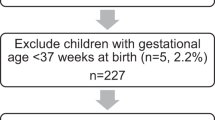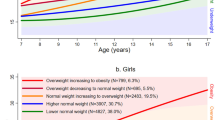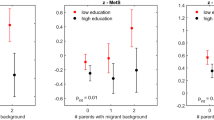Abstract
It has recently been suggested that there are substantial differences in mother–daughter and father–son associations of body mass index and obesity among contemporary UK children, but much larger studies of older cohorts have failed to find evidence of substantial sex-specific effects. We have tested this hypothesis using the Avon Longitudinal Study of Parents and Children, a large contemporary cohort. Our analyses are based on 4654 complete parent–offspring trios (2323 with male offspring and 2331 with female offspring, all aged approximately 7.5 years). We found maternal body mass index to be a little more strongly associated with female than with male offspring body mass index (β=0.18 (95% confidence interval 0.16–0.20) for females vs 0.13 (0.12, 0.15) for males). However, associations between paternal body mass index and male compared with female offspring were very similar (β=0.16 (0.14, 0.19) for females vs 0.15 (0.12, 0.17) for males). Hence, our study suggests that there is no compelling reason to integrate the belief that there are large differences in parent–offspring body mass index associations with obesity prevention strategies.
This is a preview of subscription content, access via your institution
Access options
Subscribe to this journal
Receive 12 print issues and online access
$259.00 per year
only $21.58 per issue
Buy this article
- Purchase on Springer Link
- Instant access to full article PDF
Prices may be subject to local taxes which are calculated during checkout
Similar content being viewed by others
References
Perez-Pastor EM, Metcalf BS, Hosking J, Jeffery AN, Voss LD, Wilkin TJ . Assortative weight gain in mother-daughter and father-son pairs: an emerging source of childhood obesity. Longitudinal study of trios (EarlyBird 43). Int J Obes 2009; 33: 727–735.
Lake JK, Power C, Cole TJ . Child to adult body mass index in the 1958 British birth cohort: associations with parental obesity. Arch Dis Child 1997; 77: 376–381.
Kivimäki M, Lawlor DA, Davey Smith G, Elovainio M, Jokela M, Keltikangas-Jarvinen L et al. Substantial intergenerational increases in body mass index are not explained by the fetal overnutrition hypothesis: The Cardiovascular Risk in Young Finns. Am J Clin Nutr 2007; 86: 1509–1514.
Golding J, Pembrey M, Jones R . ALSPAC study team. ALSPAC-the Avon Longitudinal Study of Parents and Children. I. Study methodology. Paediatr Perinat Epidemiol 2001; 15: 74–87.
Davey Smith G, Steer C, Leary S, Ness A . Is there an intrauterine influence on obesity? Evidence from parent–child associations in the Avon Longitudinal Study of Parents and Children (ALSPAC). Arch Dis Child 2007; 92: 876–880.
Danielzik S, Langase K, Mast M, Spethmann C, Müller MJ . Impact of parental BMI on the manifestation of overweight 5–7 year old children. Eur J Nutr 2002; 41: 132–138.
Author information
Authors and Affiliations
Corresponding author
Ethics declarations
Competing interests
The authors declare no conflict of interest.
Rights and permissions
About this article
Cite this article
Leary, S., Davey Smith, G. & Ness, A. No evidence of large differences in mother–daughter and father–son body mass index concordance in a large UK birth cohort. Int J Obes 34, 1191–1192 (2010). https://doi.org/10.1038/ijo.2010.60
Received:
Revised:
Accepted:
Published:
Issue Date:
DOI: https://doi.org/10.1038/ijo.2010.60
Keywords
This article is cited by
-
A longitudinal study investigating change in BMI z-score in primary school-aged children and the association of child BMI z-score with parent BMI
BMC Public Health (2020)
-
Parental overweight and hypertension are associated with their children’s blood pressure
Nutrition & Metabolism (2019)
-
Epigenetic effects of paternal diet on offspring: emphasis on obesity
Endocrine (2015)
-
Familial correlation and aggregation of body mass index and blood pressure in Chinese Han population
BMC Public Health (2013)
-
Preventing and treating childhood obesity: time to target fathers
International Journal of Obesity (2012)



